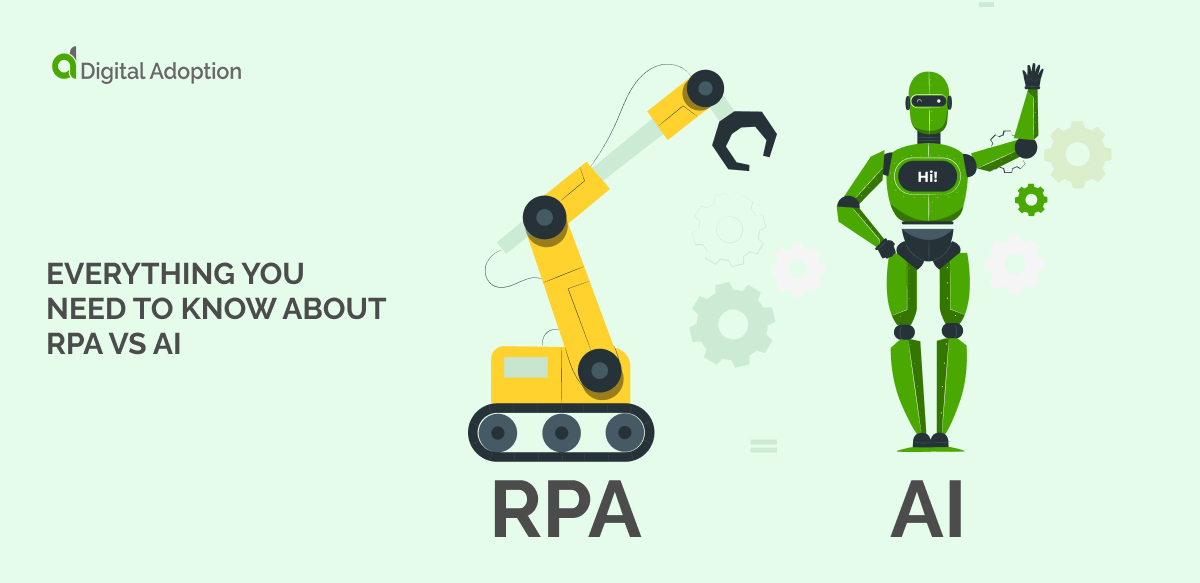Today, artificial intelligence (AI) is one of the most significant technologies used to augment every aspect of the business workflow.
But could you optimize your business processes using robotic process automation software (RPA) instead? Or a combination of both?
RPA and AI are similar, but not when you dive deeper into each and align these technologies to your business goals and processes to see which is best for your needs.
The AI market is likely to reach USD 407 billion by 2027, so now is the best time to invest in AI or RPA to get the competitive edge you need to succeed.
To help you understand RPA vs. AI, we will explore the following topics:
- Intelligent automation (IA)
- RPA vs AI: What’s the difference?
- Top 3 pros and cons of RPA vs AI
- How to choose RPA or AI for your organization
Intelligent automation (IA)
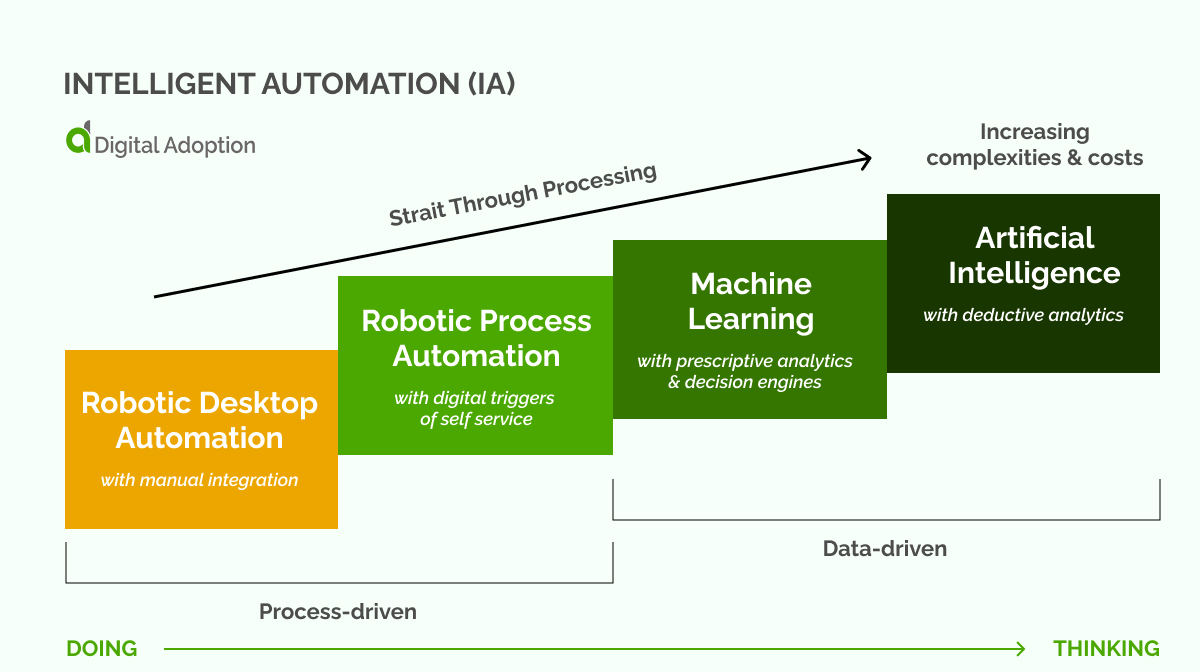
RPA and AI are both on a sliding scale called the intelligent automation scale, which covers every type of automotive technology designed to automate tasks for humans.
GRAPH
You can use the intelligent automation graph to help you identify how your business needs align with either RPA or AI and drive your decision to invest in one of these technologies.
RPA vs AI: What’s the difference?
Many similarities between RPA and AI make it challenging to understand the differences as they both have capabilities to improve business workflow automation. However, knowing these differences is crucial to understanding how to use each. Let’s begin by looking at each individually.
Robotic process automation (RPA) is a cutting-edge software technology that simplifies the creation of software robots, their deployment, and management using rules-based tasks for intelligence process automation.
These robots mimic human actions when interacting with digital systems and software, bringing efficiency and effectiveness to various processes.
Artificial intelligence (AI) refers to using computers to perform tasks that typically need human intelligence. AI can accomplish feats beyond human capabilities by processing vast amounts of data.
TABLE
Let’s look at those terms in a little more detail to help nail down the difference:
RPA
Robotic process automation (RPA) is a software tool that emulates human actions repetitively.
It automates tasks based on predefined rules, although it lacks intelligent capabilities, and organizations can use it within business process automation (BPA) practices to automate tasks.
RPA has significantly impacted large enterprises by accurately conducting structured data entry and processing without manual intervention and avoiding the organizational problems caused by unstructured data storage.
The ultimate goal is to develop RPA further to streamline and automate mundane and repetitive business processes.
AI
Artificial Intelligence (AI) refers to the capability of machines to simulate human intelligence, enabling them to think and act in ways that resemble human behavior.
Artificial intelligence (AI) entails strategic thinking akin to a chess game. It’s helpful to view it as a form of cognitive prowess and mental strategizing.
AI is a fusion of NLP (natural language processing) and ML (machine learning). It empowers users to create rule-based engines for automating repetitive tasks more efficiently.
AI functions as decision-making software, facilitating the automation of decision-making processes without requiring human intervention. Using AI in this way empowers organizations to streamline operations, enhance efficiency, and expedite outcomes.
The differences between RPA and AI
At its core, RPA is primarily focused on execution, while AI focuses on cognition and knowledge acquisition. Think of RPA as the heart of your organization that keeps rhythm and AI as the brain that creates thoughts.
Top 3 pros and cons of RPA vs AI
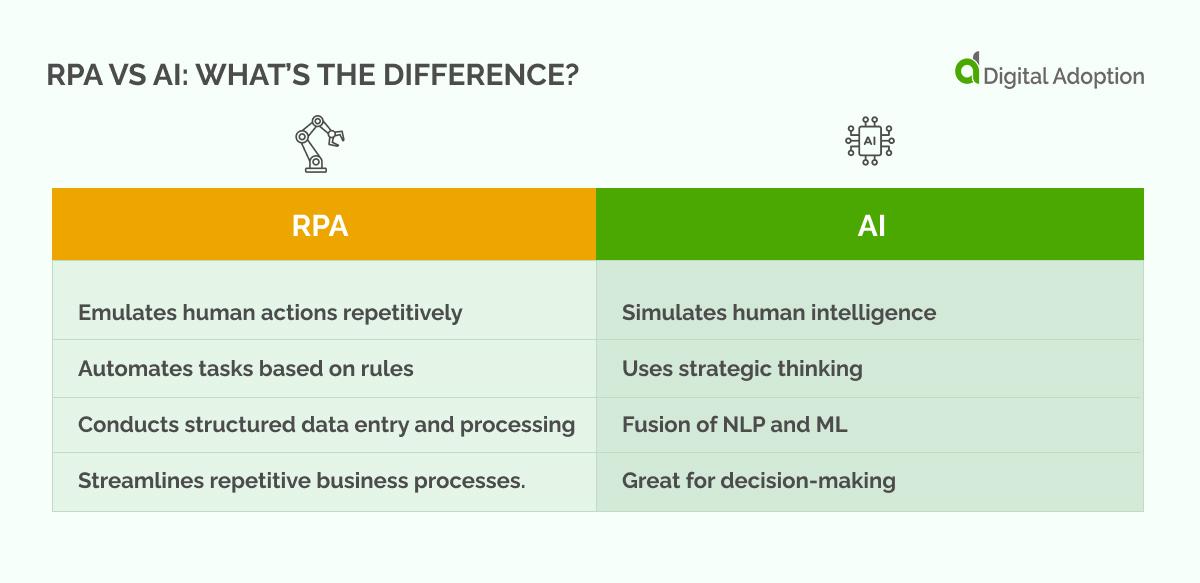
Consider these pros and cons of RPA versus AI carefully before investing in either technology.
RPA: Top 3 Pros
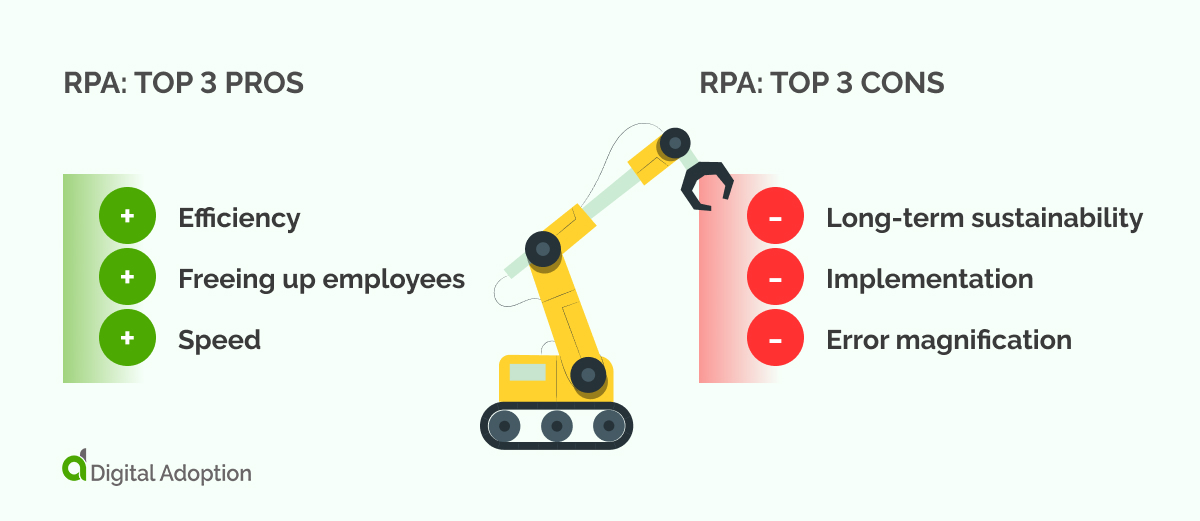
The three main pros to using RPA are as follows.
- Efficiency
A finely-tuned RPA can autonomously handle any repetitive task that would typically fall within the realm of human responsibility. This ability to automate repetitive tasks ensures efficiency while maintaining the essence of the original task.
- Freeing up employees
When employees focus on a task suitable for automation through RPA, they waste an opportunity to optimize their time on potentially more complex tasks that RPA cannot do. RPA can free up employees to focus on more complex tasks.
- Speed
A PA robot excels at performing repetitive tasks quickly and tirelessly, surpassing human capabilities. If you become hindered by a time-consuming task that hampers productivity, RPA offers an effective solution to address this challenge.
RPA: Top 3 Cons
The three main cons of using RPA include the following points.
- Long-term sustainability
Implementing RPA can sometimes divert attention from the crucial long-term efforts required for digitalization and improving the efficiency of processes and administrative tasks.
There is a potential risk of prioritizing quick fixes over establishing the correct foundations.
- Implementation
While RPA can provide value in individual tasks, it’s essential to acknowledge the time and cost involved in its setup. Cutting corners on RPA implementation is ill-advised, as misalignment can result in errors.
- Error magnification
RPA robots cannot identify glaring errors that a human would quickly notice. In cases where your data contains issues, RPA robots will simply proceed without flagging them, potentially amplifying a mistake you could have otherwise detected.
AI: Top 3 Pros
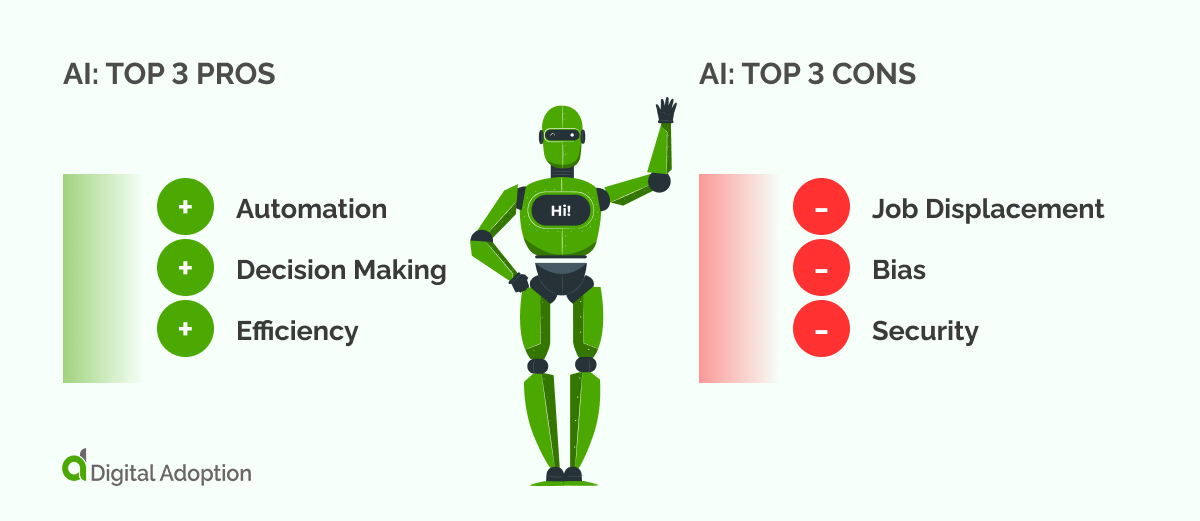
There are several pros to using AI in your organization, including the following:
1. Automation
AI can automate various tasks that humans presently perform, which is one of its primary advantages.
Consider data entry, data analysis, and customer service, just to name a few examples. By implementing automation in these processes, businesses can save valuable time and enhance efficiency.
2. Decision Making
Artificial Intelligence (AI) has the ability to rapidly and accurately analyze massive volumes of data.
This makes it an invaluable tool for decision-making tasks, as it can uncover intricate patterns and trends that may elude human perception.
By providing valuable insights, AI empowers businesses to make informed decisions and gain a competitive edge in their respective industries.
3. Efficiency
Artificial intelligence (AI) surpasses human capabilities in speed and accuracy in task completion. This efficiency enhances productivity, reduces costs, and boosts customer satisfaction.
For instance, the automation of supply chain management through AI streamlines inventory and logistics, saving precious time and resources.
AI: Top 3 Cons
There are three top cons to AI to consider:
1. Job Displacement
One of the greatest apprehensions surrounding AI is its potential to replace human beings. With the progress of automation, there is a decrease in human job opportunities, leading to economic and social upheaval.
While AI may generate new employment prospects in specific sectors, it can also lead to job redundancies, particularly in industries heavily reliant on manual labor.
2. Bias
The training AI receives directly impacts its objectivity. If the data used for training contains biases, the resulting AI will also exhibit biases. This situation can lead to discriminatory and unfair treatment of certain groups.
For instance, if an AI algorithm receives training on biased data discriminating against specific racial or ethnic groups, its recommendations or decisions may perpetuate these biases.
3. Security
Artificial intelligence is vulnerable to hacking and cyberattacks, posing a significant risk to confidential data. The potential consequences for individuals and businesses are grave.
For instance, if an AI system is compromised, it could expose private information or allow for substantial financial losses.
How to choose RPA or AI for your organization
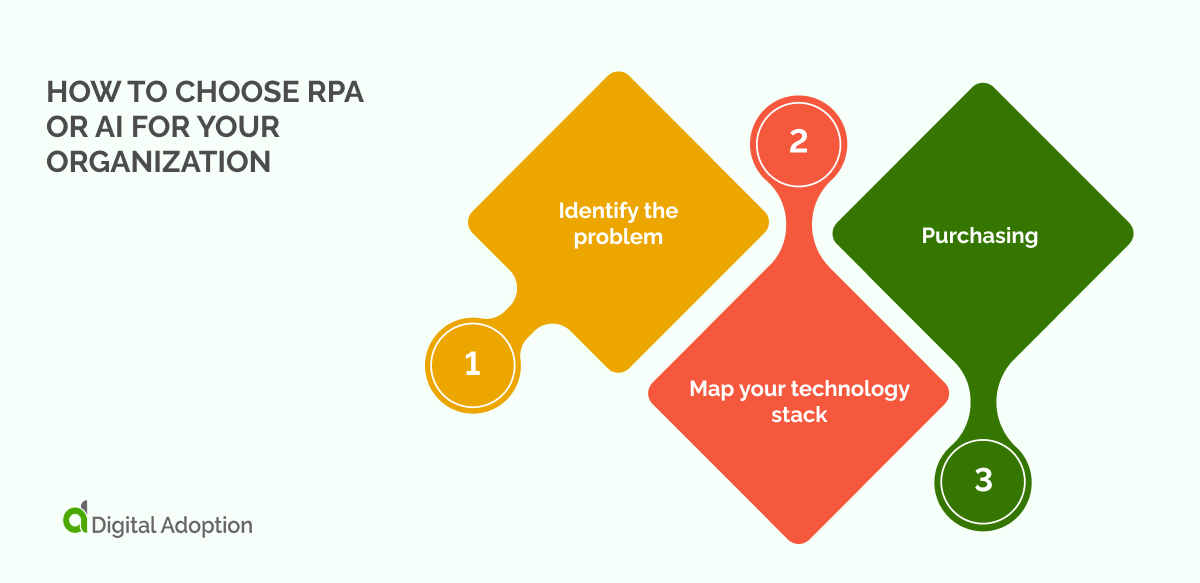
On the surface, RPA and AI appear to be very similar, but their use cases are very different. Therefore, it is essential to consider the business goals you want to meet to ensure you choose the right technology before investing.
1. Identify the problem
Given the wide range of choices available, it’s unsurprising that business leaders find it challenging to select suitable options when deciding between RPA and AI for their companies.
Although it may be tempting for them to follow the crowd and choose what’s currently popular, it is wise to disregard the latest trends and make informed decisions based on your own circumstances.
Another error to avoid is purchasing technology based on brand familiarity or a recommendation from another company.
Before considering available options in the market, firms must identify the underlying causes of business challenges, emphasizing the expert.
Failing to do so may result in the misallocation of IT budgets towards technologies that fail to address the issues and introduce new complications.
2. Map your technology stack
The best first step for your tech stack is to audit your digital infrastructure. This evaluation will gauge each tool’s efficiency, identify those no longer suitable for their intended purpose, and help you decide if AI or RPA is the best addition to your existing tech stack.
You will probably encounter numerous manual processes and outdated technology that no longer benefits the business.
Once you have revealed the actual state of your current situation, you can then initiate a discussion about what is necessary and what you can discard.
The next crucial step after mapping the tech stack is ensuring effective integration, integrity, and data governance concerning RPA or AI.
Your company’s capability to manage the diverse operational data it generates directly impacts the success of its digital transformation strategy.
Companies must prioritize consistent and reliable data flow across all departments while assessing its credibility.
You can leverage this valuable resource to proactively monitor the health of technology stacks and extract actionable insights that inform decision-making.
3. Purchasing
Companies can explore the tech market and make informed decisions after identifying the underlying issues, organizing their technology infrastructure, and establishing a solid data governance framework.
Many boards may hesitate to implement drastic changes, particularly when adopting new technologies like RPA or AI, especially during economic uncertainty.
As a result, they might be reluctant to allocate substantial digital technology investments into your transformation.
If that’s the situation, it might be worthwhile to begin on a smaller scale and concentrate on a manageable process that requires improvement.
While there is nothing inherently wrong with testing the waters in this manner, it’s crucial to think big and strategize for the long term, as emphasized by Lupton.
According to Lupton, your requirements will inevitably change as your firm evolves. Therefore, selecting scalable technology to grow alongside the business is crucial. Ensuring adaptability and scalability is essential for long-term success.
Choose the right partner for your RPA vs AI journey
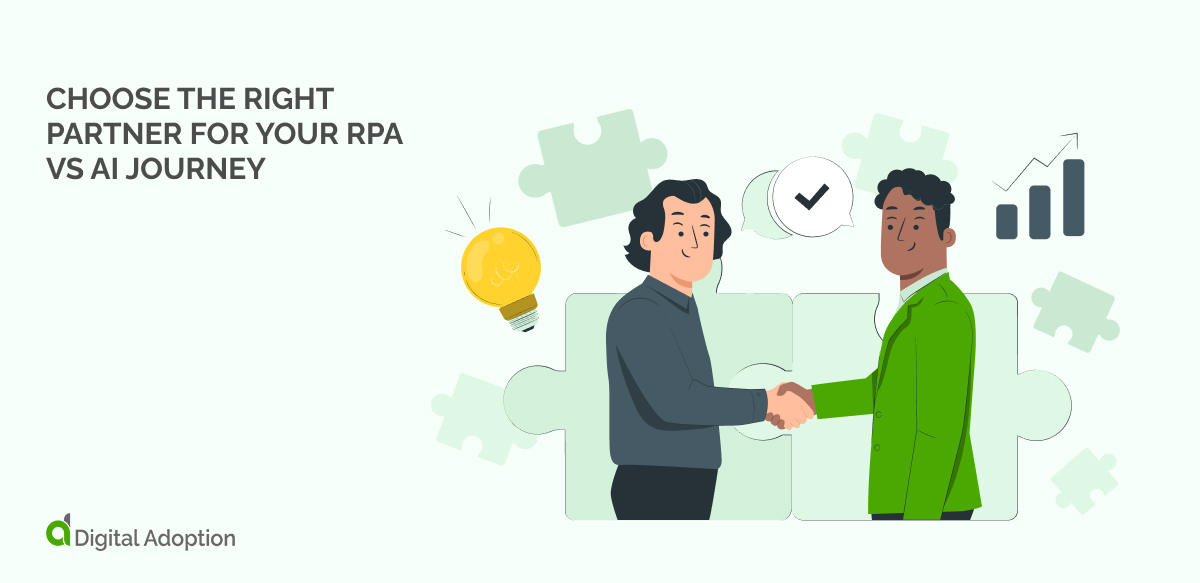
Digital transformation is an ongoing journey, not just a single project. Having the right partner by your side will enable you to derive the utmost value from the chosen digital technology throughout its entire lifespan until the time comes to explore new options again.
An experienced partner will allow you to identify what you need out of new technology investments and whether to choose RPA, AI, or both, to streamline your transformation efforts for higher digital resilience and business success.

